
The straw underwing is a species of moth in the family Noctuidae. The species was first described by Johann Siegfried Hufnagel in 1766. It is found from North Africa west through South Europe and Central Europe. In the north it is in parts of Ireland, Scotland, Sweden, Norway, Finland and Estonia. Further east the range stretches from southern Russia and Asia minor to the Caucasus.

Globia sparganii, or Webb's wainscot, is a moth of the family Noctuidae. The species was first described by Eugenius Johann Christoph Esper in 1790. It is found in Europe, Central Asia, from southern Siberia to Manchuria, Korea, Turkey, Syria and Iran.
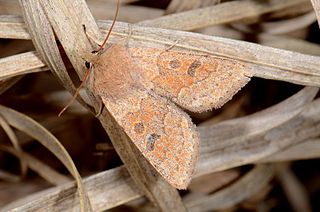
Orthosia miniosa, the blossom underwing, is a moth of the family Noctuidae. The species was first described by Michael Denis and Ignaz Schiffermüller in 1775. It is found in Europe.

Asteroscopus sphinx, the sprawler, is a moth of the family Noctuoidea. It is found throughout western Europe, but is mainly a Northern species occurring South to Northern Spain the southern edge of the Alps, Central Italy and Northern Greece. North to southern Sweden. East to Kaliningrad and Moscow. Also in Central Europe, Turkey, the Caucasus and Asia Minor.

Atethmia centrago, the centre-barred sallow, is a moth of the family Noctuidae. The species was first described by Adrian Hardy Haworth in 1809. It is found in Europe except Scandinavia and Italy; also in Asia Minor, Armenia, Syria and Palestine.

Mormo maura, the old lady or black underwing, is a species of moth of the family Noctuidae. The species was first described by Carl Linnaeus in the 10th edition of his Systema Naturae. It is found in the Palearctic realm, from north-western Africa through all over southern Europe. It reaches its northern border in the west in northern Ireland and central Scotland, in central Europe, in northern Germany and Poland. In some Nordic countries, there are single finds. The other occurrence areas include Turkestan, Anatolia, the Middle East and Iraq. The name "old lady" refers to the fact that the wing pattern was said to resemble the shawls worn by elderly Victorian ladies.

Lacanobia thalassina, the pale-shouldered brocade, is a moth of the family Noctuidae. It is found in Europe east across the Palearctic to the Russian Far East and Siberia.
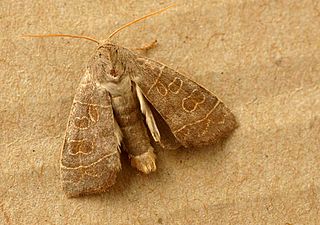
Ipimorpha subtusa, the olive, is a moth of the family Noctuidae. It is found in the Palearctic realm.
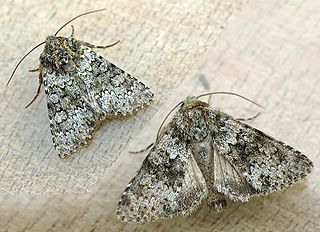
Hecatera dysodea, the small ranunculus, is a moth of the family Noctuidae. It is found in Europe, primarily in Central Europe and Southern Europe The northern boundary of the distribution is from the Baltic Sea and the southern part of Lithuania, Belarus, south of Moscow to the Urals. North Africa forms the distribution border in the south east they extend to the Middle East, Turkestan and across the Palearctic to Central Asia. It is an introduced species in North America, where it was first found in Utah in 1998 and Oregon in 2005.

Protarchanara brevilinea, or Fenn's wainscot, is a moth of the family Noctuidae. The species was first described by Charles Fenn of Lewisham who collected specimens during an entomological excursion to Ranworth in 1864. It is found in western and northern Europe.

Panemeria tenebrata, the small yellow underwing, is a moth of the family Noctuidae. The species was first described by Giovanni Antonio Scopoli in his 1763 Entomologia Carniolica. It is found in Europe but is missing in northern Scandinavia, in Portugal, in central and southern Spain, as well as on most Mediterranean islands, except Sicily. In the east, the range extends to the Ural Mountains, but the east distribution limits are still insufficiently known. Occurrence in Asia Minor is uncertain, but it is known from Jordan and Israel.

Noctua fimbriata, the broad-bordered yellow underwing, is a moth of the family Noctuidae. It is found in Europe, North Africa, Anatolia, the Caucasus, Turkey, Caucasus, Transcaucasia, Armenia, Turkmenistan and Novosibirsk Oblast. The border of its southern range is unclear because of the similar looking species Noctua tirrenica.

Catocala electa, the rosy underwing, is a moth of the family Erebidae. The species was first described by Karl Friedrich Vieweg in 1790. It can be found in Europe and Asia.
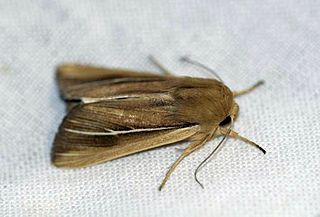
Mythimna litoralis, the shore wainscot, is a moth of the family Noctuidae.

Catocala nymphagoga, the oak yellow underwing, is a moth of the family Erebidae. It is found in Southern Europe, from Bulgaria up to the Iberian Peninsula and sometimes further north as a migrant. It is also found in North Africa and Asia Minor.

Coranarta cordigera, the small dark yellow underwing, is a moth of the family Noctuidae. The species was first described by Carl Peter Thunberg in 1788. It can be found in parts of Europe, mainly in the north. In central and southern Europe it is only found in mountainous areas. In the Alps for instance, it is found up to elevations of 2,200 meters.

Anarta myrtilli, the beautiful yellow underwing, is a moth in the family Noctuidae. The species was first described by Carl Linnaeus in 1761. It is found in most of Europe including Scandinavia, Britain, France, Germany, Switzerland, Spain, Portugal, Italy, and Russia.
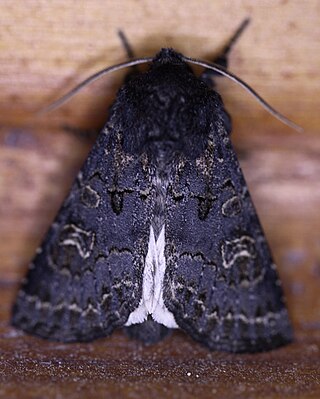
Tholera cespitis, the hedge rustic, is a moth of the family Noctuidae. The species was first described by Michael Denis and Ignaz Schiffermüller in 1775. It is found through the Palearctic from Europe to the Altai Mountains of Siberia.

Athetis hospes, or Porter's rustic, is a moth of the family Noctuidae which was described by Christian Friedrich Freyer in 1835. It is found in Spain, southern France, Italy, on the Balkan Peninsula, Crete, Turkey and northern Iran. The species seems to be expanding its range in north-western Europe with records from Great Britain and the Netherlands.

Hoplodrina superstes, also known as the powdered rustic, is a moth of the family Noctuidae, first described by Ferdinand Ochsenheimer in 1816. It is found in Asia and Europe.























